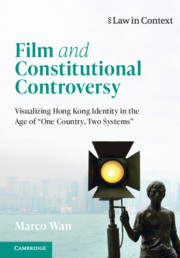 Film and Constitutional Controversy
Film and Constitutional Controversy Johnnie To’s Justice, My Foot!*
Published online by Cambridge University Press: 05 February 2021
In Chapter 2, I situate Johnnie To’s popular comedy, Justice, My Foot! (1992 審死官), which revolves around a lawyer defending a woman falsely accused of murdering her husband, in light of the drafting of the Basic Law and passage of the Bill of Rights in early-1990s Hong Kong. I argue that To’s film, which appeared at cinemas a mere three years after the 1989 Tiananmen Square crackdown in Beijing, can be approached as a screening of a nightmare scenario on the minds of many viewers at the time: A Hong Kong-style lawyer trying to defend the innocent and maintain justice in a Chinese-style legal system that disregards basic human rights and that is plagued by corruption and nepotism. I will then explore the function of humor in the film to show how Justice, My Foot! repackages anxieties about the sinicization of law into a marketable cultural product for mass consumption.
To save this book to your Kindle, first ensure no-reply@cambridge.org is added to your Approved Personal Document E-mail List under your Personal Document Settings on the Manage Your Content and Devices page of your Amazon account. Then enter the ‘name’ part of your Kindle email address below. Find out more about saving to your Kindle.
Note you can select to save to either the @free.kindle.com or @kindle.com variations. ‘@free.kindle.com’ emails are free but can only be saved to your device when it is connected to wi-fi. ‘@kindle.com’ emails can be delivered even when you are not connected to wi-fi, but note that service fees apply.
Find out more about the Kindle Personal Document Service.
To save content items to your account, please confirm that you agree to abide by our usage policies. If this is the first time you use this feature, you will be asked to authorise Cambridge Core to connect with your account. Find out more about saving content to Dropbox.
To save content items to your account, please confirm that you agree to abide by our usage policies. If this is the first time you use this feature, you will be asked to authorise Cambridge Core to connect with your account. Find out more about saving content to Google Drive.